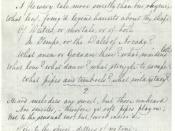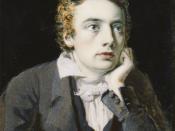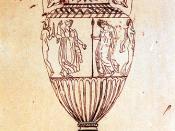Commentary
The speaker says that she died for Beauty, but she was hardly adjusted to her tomb before a man who died for Truth was laid in a tomb next to her. When the two softly told each other why they died, the man declared that Truth and Beauty are the same, so that he and the speaker were "Brethren." The speaker says that they met at night, "as Kinsmen," and talked between their tombs until the moss reached their lips and covered up the names on their tombstones.
This poem follows many of Dickinson's typical formal patterns--the ABCB rhyme scheme, the rhythmic use of the dash to interrupt the flow--but has a more regular meter, so that the first and third lines in each stanza are iambic tetrameter, while the second and fourth lines are iambic trimeter, creating a four-three-four-three stress pattern in each stanza.
This bizarre, allegorical death fantasy recalls Keats ("Beauty is Truth, Truth Beauty," from Ode on a Grecian Urn), but its manner of presentation belongs uniquely to Dickinson.
In this short lyric, Dickinson manages to include a sense of the macabre physicality of death ("Until the Moss had reached our lips--"), the high idealism of martyrdom ("I died for Beauty. . . One who died for Truth"), a certain kind of romantic yearning combined with longing for Platonic companionship ("And so, as Kinsmen, met a Night--"), and an optimism about the afterlife (it would be nice to have a like-minded friend) with barely sublimated terror about the fact of death (it would be horrible to lie in the cemetery having a conversation through the walls of a tomb). As the poem progresses, the high idealism and yearning for companionship gradually give way to mute, cold death, as the moss creeps up the...



E.Dickinson
Well written :) I haven't ever read much of Dickinson's work, therefore I found this essay informative and also fun to read because it is written colorfully with good description.
2 out of 3 people found this comment useful.